Three Rs potential in the development and quality control of pharmaceuticals
Main Article Content
Abstract
The intention of a pharmaceutical company is to develop new, efficient products quick and with a minimum of costs. Compared to in vitro methods, animal experiments in general consume much more time and resources (costs as well as time to the market) thanin vitro methods. Therefore, the use of whole animal models depends primarily on the judgement of their efficacy in the screening process, but the willingness to incorporatein vitro methods in general is high and is furthered by new developments such as high-throughput screening. Nevertheless,in vitro tests might be politically promoted by increasing their costs (quality controls, requested housing conditions) and duration (time to start of an experiment, sequential performance).Which models are favoured by industry to include them in a screening process: They have to be based on our most recent understanding of the respective disease, well characterised to allow interpretation of results and require only limited development time. All these aspects argue in favour of collaboration between industry and academia, where our understanding of pathophysiology is generated and mechanism based models are developed and characterised. However, technology transfer towards industry represents a bottle-neck for industrial use of these newin vitro models. New platforms to promote this transfer should be developed in order to bring together developer and user of novel in vitro systems and promote demonstration projects. Financing of such collaborations is not the key problem (the development of a single drug makes up to 500 million $) but the dilemma of publication of results: The development advantage compared to competitors depends on the exclusive use of novel models. The protection of intellectual property rights and the public interest in spreading alternatives to animal experiments must be balanced, e.g. by delayed but indispensable publication or advantages for companies employing alternatives in the regulatory approval process for a new drug.
Quality control of therapeutic drugs (except hormones and blood products) represents a minor field of animal consumption with the exception of pyrogenicity testing. Despite considerable progress due to the introduction of the Limulus assay which represents the most successful in vitro alternative in use so far. However, some limitations of this in vitro test might be overcome in the near future by the currently validated human whole blood assay. During the last few years considerable progress has been made in the replacement (and deletion) of animal tests required for the potency and safety testing of hormones. This has been made possible by biotechnical production methods, by better-defined products, and because physico-chemical methods can be used for the potency testing of these products. In general, the better defined a drug is, the easier chemical, physical orin vitro techniques can be used for batch control. Control authorities should therefore urge the use of highly standardised components.
Article Details

This work is licensed under a Creative Commons Attribution 4.0 International License.
Articles are distributed under the terms of the Creative Commons Attribution 4.0 International license (http://creativecommons.org/licenses/by/4.0/), which permits unrestricted use, distribution and reproduction in any medium, provided the original work is appropriately cited (CC-BY). Copyright on any article in ALTEX is retained by the author(s).


